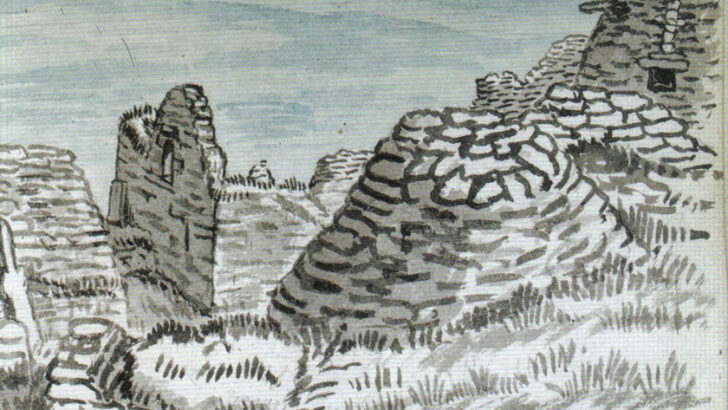Monasticism in Ireland AD 900-1250,
by Edel Bhreathnach
(Four Courts Press, €45 / £51.50)
This volume arises from the Monastic Ireland project begun in 2011 and is a follow-up to Monastic Europe (Brepols, 2019), edited by the author. It provides an extremely wide-ranging overview of academic developments in the almost hundred years since John Ryan’s seminal work: Irish monasticism: origins and early development (Talbot Press, 1931).
Ryan’s stated purpose was not to supply conclusions, but to stimulate scholarly interest in early Irish ecclesiastical history. This book has a similar aim: the author refers throughout to the fact that she is providing an illustrative selection of the evidence and to the need for further debates on particular questions.
The book is divided into nine chapters, each covering around fifty pages, with a focus on the ninth to twelfth centuries. Unlike Ryan, Bhreathnach is uninterested in pinpointing origins, and the definition of monasticism used is intentionally broad: a community or solitaries living a committed religious life under the direction of a superior, often within a separate area on larger church settlements.
The book breaks new ground in, among other matters, its very extensive use of Middle Irish poetry and in highlighting the diversity of terms used in this era for monastic personnel”
They were distinguished by dedication to constant prayer, penitential exercises, celebrating canonical hours and following a liturgical calendar. Humility and obedience were central to their lives, but permanent chastity was less so (p. xi-xii).
Key to the discussion is the extent to which Ireland shared in a rich and diverse group of Christian ‘monasticisms’. The very diverse texts written in Irish provide a vivid counterpoint to descriptions of the latter and lead to the conclusion that, while the substantive Christian beliefs and values were held in common with the contemporary universal Church, cultural forms observable in documentation and material remains have tended to highlight Irish distinctiveness.
Diversity
The book breaks new ground in, among other matters, its very extensive use of Middle Irish poetry and in highlighting the diversity of terms used in this era for monastic personnel. These include the replacement of older words for superiors with phrases based on cenn and toísech (modern Taoiseach); the use of sámud for the wider church community, especially where it engaged in temporal matters and the identification of the adjective cráibdech (meaning pious or devout) with a learned monastic élite who may have held supervisory positions over the committed religious of Ireland.
Divisions between spiritual and worldly affairs – what Liam Breatnach terms the gráda ecalsa and the gráda uird ecalsa, “grades of office of the church” – are seen as the concerns of separate groups.
Remarks on Skellig Michael are emblematic of changes in perspective. Instead of lives lived in isolation, the emphasis is on height, of leaning towards heaven and creating a New Jerusalem”
It is worth noting that Augustine argued somewhat differently, suggesting that a life lived without service to others could be viewed as potentially self-indulgent although the Rule of the Master, as pointed out here (p.202), advises against spiritual men involving themselves in worldly affairs. In this, as in so much else in this volume, there is much for readers to ponder and debate.
The task of sustaining a shared ideal is compared to contemporary evidence for bonds uniting kinship groups, warrior brotherhoods and specialised professions. It is repeatedly stressed that the Rule of Benedict, as the dominant medieval rule in the Latin west, was still being formalised in this period and so did not provide a universal blueprint.
Given the harsh tone of much discourse today, it is perhaps worth stressing that the Irish Rule of Ailbhe lays stress on compassion and leniency to those who transgress and that, while some texts refer to ascetic practices such as fasting and even flagellation, others stress a stable existence, self-criticism, prayer and, for at least some, reading, learning and pondering the Scriptures as key tools in combating Cassian’s eight deadly sins.
Since the advent of digital scanning and the Irish Script on Screen project, manuscript studies have grown substantially and this book graphically illustrates the value of the new insights.
Emblematic
Remarks on Skellig Michael are emblematic of changes in perspective. Instead of lives lived in isolation, the emphasis is on height, of leaning towards heaven and creating a New Jerusalem (p.268). Michael the Archangel was the role model for the monk as miles Christi and archaeological investigations show its inhabitants, like other armies, were largely dependent on foodstuffs provided by others and brought from the mainland (p.249).
Though the author states that it was inhabited ‘probably continuously’ in this era (p.306), the relatively busy community demonstrated by the existence of various monuments, may, in fact, have been largely limited to a summer season bringing pilgrims and people on retreat (p.375).
The vast and diverse amount of detail means that everyone reading this book will find new insights. While no single author can cover modern scholarship in its entirety, the bibliography is extremely impressive.
The book is a worthy successor to John Ryan’s work and one which, like his, is likely to become a key reference for at least another three generations.


 The monastic cells on Great Skellig, drawn by Thomas J. Westropp RIA, on June 10, 1897
The monastic cells on Great Skellig, drawn by Thomas J. Westropp RIA, on June 10, 1897